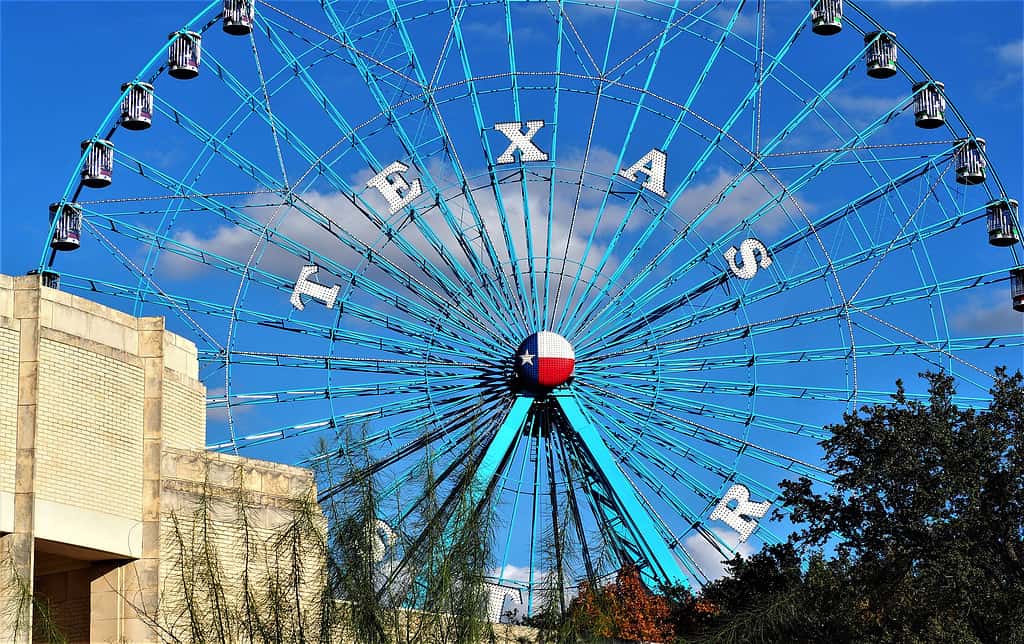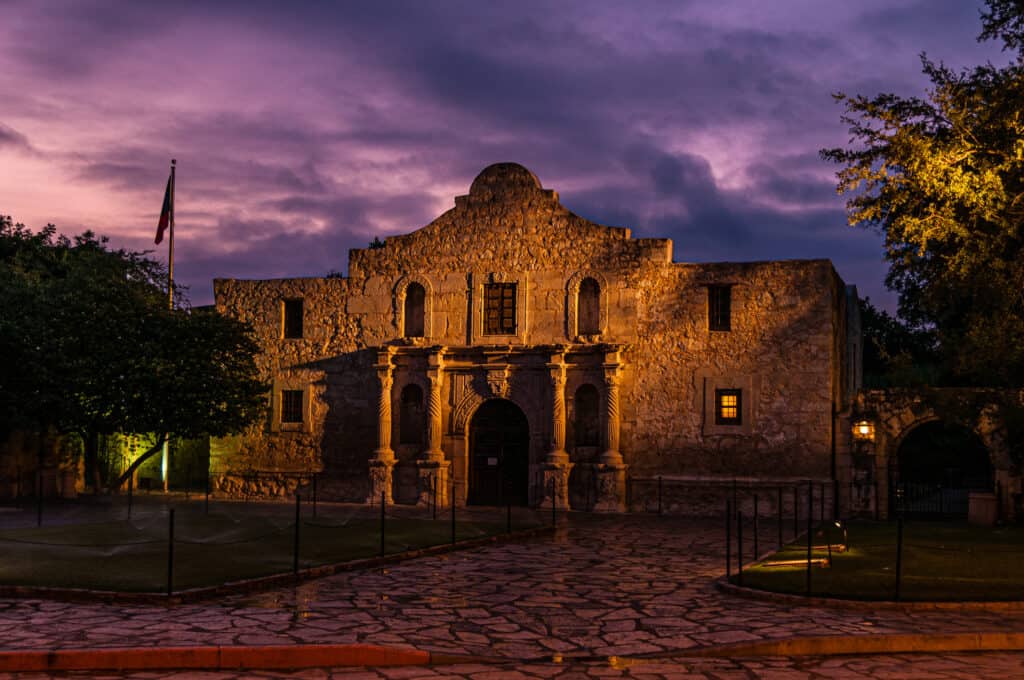The state of Texas is known for a few things: cowboys, Tex-Mex food, and The Alamo. It’s the second-largest state in the U.S. and as it’s commonly said, “Everything’s bigger in Texas!” It’s home to a few very large cities, including Dallas, Austin, and Houston.
Texas also goes by the name of “The Lone Star State.” Wondering why? There’s a rich history behind Texas’s unique nickname that dates back to the 1830s.
The Lone Star State’s nickname comes from the Lone Star Flag — a symbol of the state’s fierce independence.

A closeup shot of the Texas Star, the largest Ferris wheel in North America, displaying the lone star flag.
©MD Global/Shutterstock.com
Early Texas
Texas used to belong to Mexico and was called Coahuila y Tejas, meaning ‘Free and Sovereign State of Coahuila and Texas’. But Texas wanted independence and tensions had risen between federalist Texians and the centralists. In 1835 the tension had risen too high, and armed conflict broke out, marking the Battle of Gonzales.
This battle sprung the Texas Revolution, which followed soon after and lasted for a few months. In two months’ time, the Texians defeated all of the Mexican troops. Texians then created a provisional government of elected officials, but that collapsed quickly, and there was no governance for a few months.
During that time the Mexican President Antonio Lopez de Santa Anna led an army to end Texas’s revolt. For a bit, it looked like the army would find success. They defeated all of the Texian armies along the coast, then surrounded and overwhelmed the Texians in the Alamo.

The Alamo lit up before sunrise in San Antonio, Texas.
©iStock.com/Greg Meland
The Republic of Texas
After the Alamo, there was a lot of panic in Texas. They quickly elected new delegates to the Convention of 1836 and signed a declaration of independence. On March 2, the Republic of Texas was formed as an independent country. The Convention disbanded and the members continued on the run from the Mexican army.
After a few more weeks, Sam Houston attacked Santa Anna’s forces and forced them to sign a treaty. Signing the Treaties of Velasco ended the war and secured Texas’s independence from Mexico.
The Lone Star State
After Texas became independent from Mexico in 1836, it needed a flag. But the republic must have been indecisive because, in its short life of 9 years, it had three official flags. The Lone Star Flag was adopted in 1839 and was the third flag to fly for the republic. It consisted of “blood red, azure blue, and white”, which represented bravery, loyalty, and purity. It also had just one, lone star on the left side of the flag.
Today, the Lone Star State nickname reflects the pride that all Texans feel for their state. It’s a representation of the state’s battle for independence and it’s defiance against being controlled.

The Texas flag bears one, lone star.
©NayaDadara/Shutterstock.com
After The Treaty
While Texas may have gotten out of its battles with Mexico, the real war was just getting started. Two factions in the republic had ideas for Texas’s future. Mirabeau B. Lamar led the nationalist faction and advocated for the expulsion of Native Americans as well as the continued independence of the republic and expanding it. Sam Houston led the opposed faction which advocated for Texas to become part of the United States and to continue allowing the Native Americans to live there.
As tensions rose, they eventually broke into a war called the Texas Archive War. The war didn’t last too long, as most of the country was in agreement with being annexed into the United States. When they applied to become a part of the U.S., they were initially turned away because Texas was a slaveholding country. They were able to negotiate annexation with the U.S., though, after James K. Polk became president in 1844.
Early Statehood
Texas was a lot less populated when it first joined the U.S. than it is today. It was a mixture of citizens who spoke English and Spanish, with the English-speaking residents residing in northeast Texas and a majority of Spanish-speaking residents in the southwest. There were large herds of cattle that freely roamed Texas because of failed colonization efforts. These herds were captured and used for food or other economic reasons, thereby creating the “cowboy culture” that is prominent in Texas.
The U.S.’s annexing of Texas led to the Mexican-American war, which lasted for two years and ended with the Treaty of Guadalupe Hidalgo. After this treaty and the latter Compromise of 1850, the borders of Texas and Mexico were established, where they remain at present.

Longhorn herds roamed freely across Texas, and residents captured and used the herds for slaughter.
©Bob Pool/Shutterstock.com
Other Fun Facts About Texas
Besides being the Lone Star State, there’s a lot more that makes Texas special. Other symbols of the state include its state flower, the bluebonnet, and the state motto, which is friendship. Read on to learn more about the great state of Texas, including its official state animals!
The photo featured at the top of this post is © Paul Quinn/Shutterstock.com
Thank you for reading! Have some feedback for us? Contact the AZ Animals editorial team.






